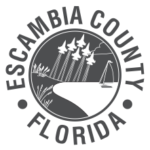
Traffic calming is the overall term for enhancements made to residential streets in order to encourage vehicles to drive the speed limit. On a larger scale, it may include reconstruction of the streets in question to add physical features such as speed bumps, traffic circles, traffic tables, etc. Escambia County currently offers three types of traffic calming programs: Municipal Services Benefit Unit (MSBU) a process requiring property owners to fund the cost to implement, Neighborhood Enhancements - Multiple Roads, and Neighborhood Enhancements - Existing Devices. Staff reviews requests and determines which category the request best falls under.
If you have a question about traffic calming or need instructions on how to get a petition processed, please email or call the Transportation and Traffic Operations Division. Our goal is to respond to all requests for traffic calming with a written outline explaining our process within five business days.
Speeding, cut-through traffic and unsafe driving practices on neighborhood streets cause concerns about the safety and livability of neighborhoods. Dangerous driving behaviors create unsafe road conditions for others, including pedestrians, bicyclists and other drivers.
In an effort to safeguard the well-being of all residents, Escambia County has invested more than $8 million in Local Option Sales Tax funds to construct traffic calming, sidewalk and other pedestrian safety projects since 2006.
Traffic Calming
Traffic calming consists of physical design, put in place on roads with the intention of slowing down or reducing motor vehicle traffic and improving safety for pedestrians and bicyclists. Although there are many strategies used by urban planners and traffic engineers, the two most common types of traffic calming methods used in Escambia County are:
Speed Tables – Speed tables are wide, flat-topped speed humps. They are typically constructed so that the entire wheelbase of a passenger car rests on the flat section. This design allows for vehicles to pass over them at a higher speed than speed humps. A textured material is sometimes used with speed tables in order to draw attention to them, enhancing safety and speed-reduction. Speed tables are good for locations where low speeds are desired but a somewhat smooth ride is needed for larger vehicles, such as fire trucks, ambulances and school buses.
Both speed bumps and speed tables have been shown to reduce traffic volumes and speed on streets where they have been installed.
Escambia County’s traffic calming program is overseen by the Transportation and Traffic Operations Division of the Engineering Department and is only installed in a neighborhood upon request. Traffic calming efforts can be funded through an MSBU, which requires adjacent property owners to fund a portion of the cost to implement. For larger projects, and with consensus of the majority of neighborhood residents, Local Option Sales Tax funding may be available.
Sidewalks
Many streets and roads in Escambia County were originally designed for automotive travel, with little consideration given to the needs of walkers. Lack of sidewalks and construction of sidewalks too close to roads discourage people from walking regularly. Well-maintained sidewalks are also important to neighborhood health because they improve the appearance of neighborhoods and increase property values. That’s why funds from the Local Option Sales Tax have been used to pay for almost $7 million in sidewalk improvements in Escambia County in recent years. In some cases, this funding has been used to leverage money obtained from grant programs such as Safe Route to Schools programs.
SRTS programs are part of the solution to increase physical activity and improve unsafe walking and bicycling conditions. Walking or biking to school allows children time for physical activity, creates a sense of responsibility and fosters independence. SRTS programs, in partnership with the Escambia/Santa Rosa Community Safety Team, place an emphasis on reducing traffic congestion, slowing vehicle speed and focusing on keeping children safe.
Teach Your Child How to Walk to School Safely: Tips from SafeRoutesInfo.org
Other Pedestrian Safety Efforts
Escambia County is also using Local Option Sales Tax funds to step up other efforts to make it easier to step out, including the installation of crosswalks in areas of high pedestrian traffic.
In order to provide the highest level of safety to those crossing at marked intersections, new crosswalks have been constructed using enhanced techniques to draw attention to pedestrians. Among these supplementary efforts are:

The mission of Escambia County government is to provide efficient, responsive services that enhance our quality of life, meet common needs and promote a safe and healthy community.
Under Florida law, IP addresses and both the content of emails and email addresses are public records. If you do not want your IP address and the content of your email or your email address released in response to a public records request, do not send electronic mail to this entity. Instead, contact this office by phone or in person.

